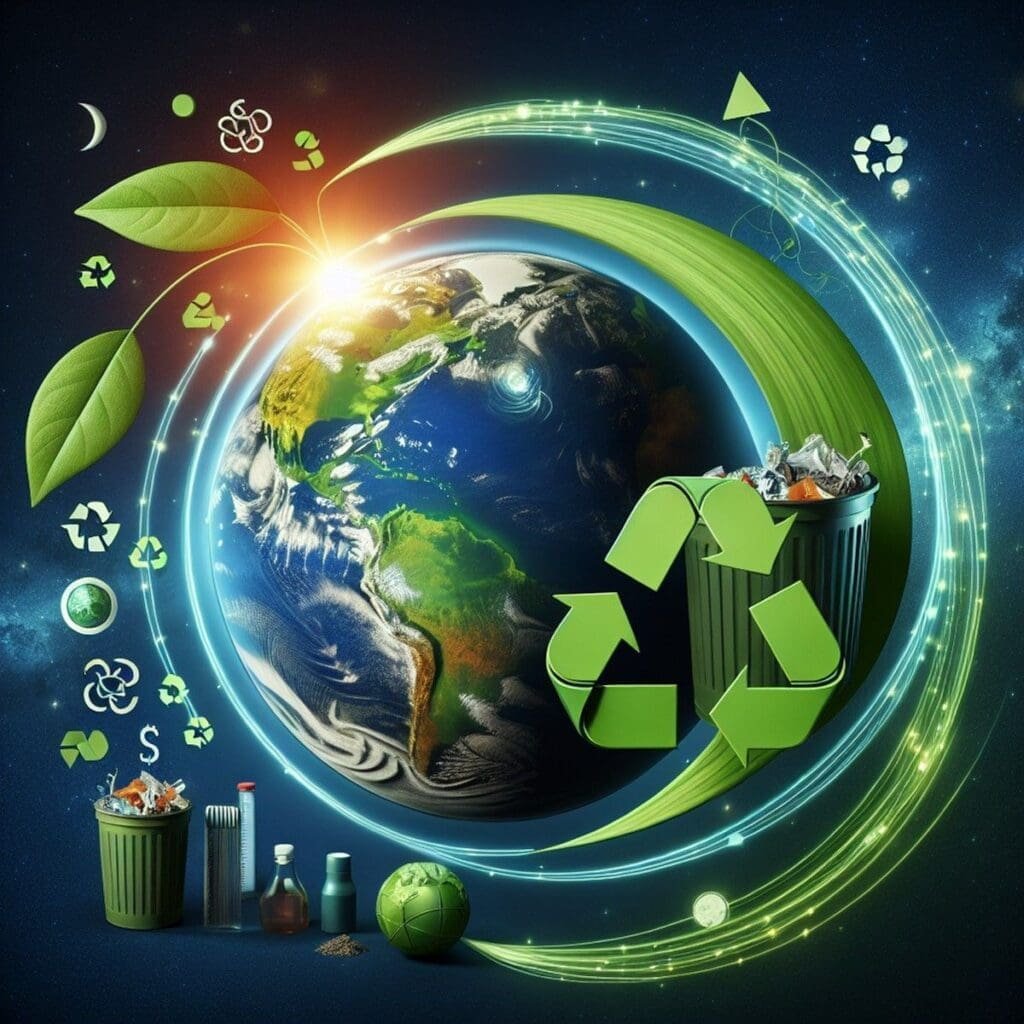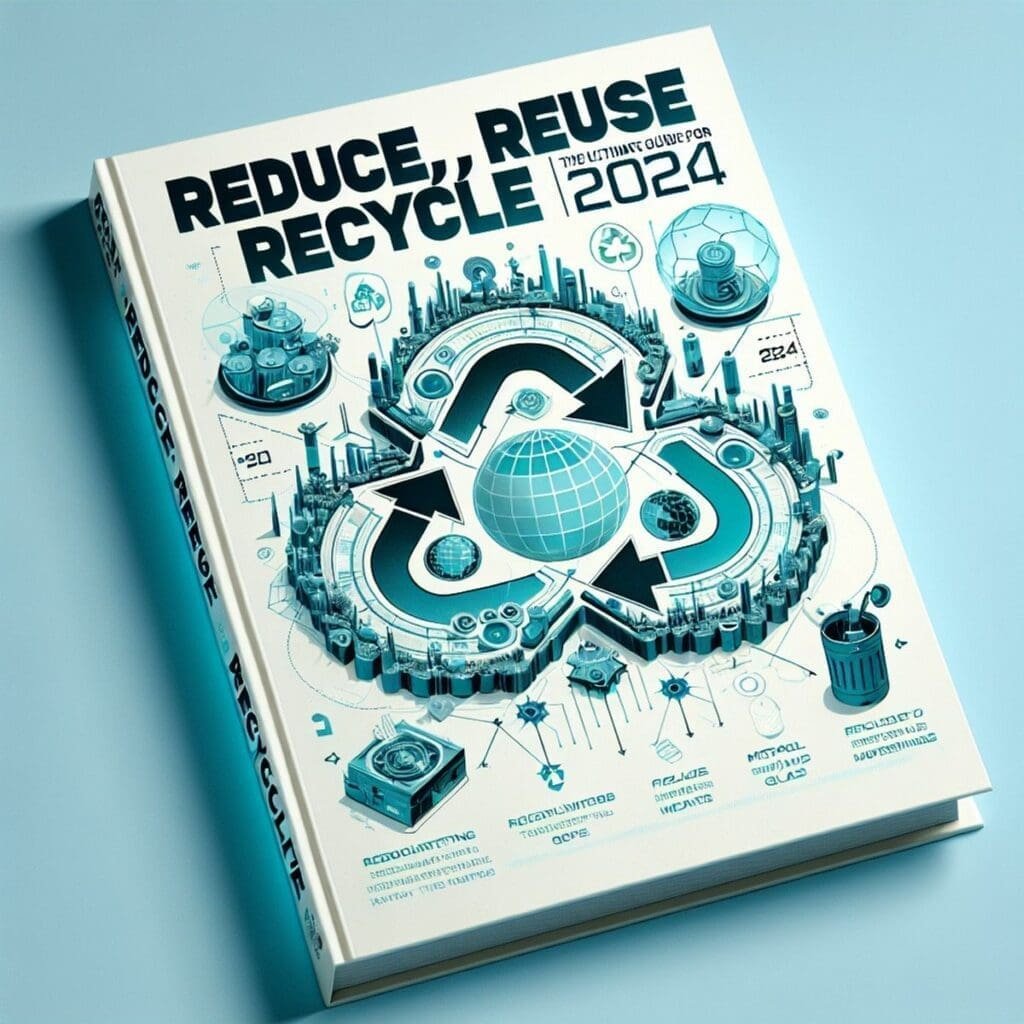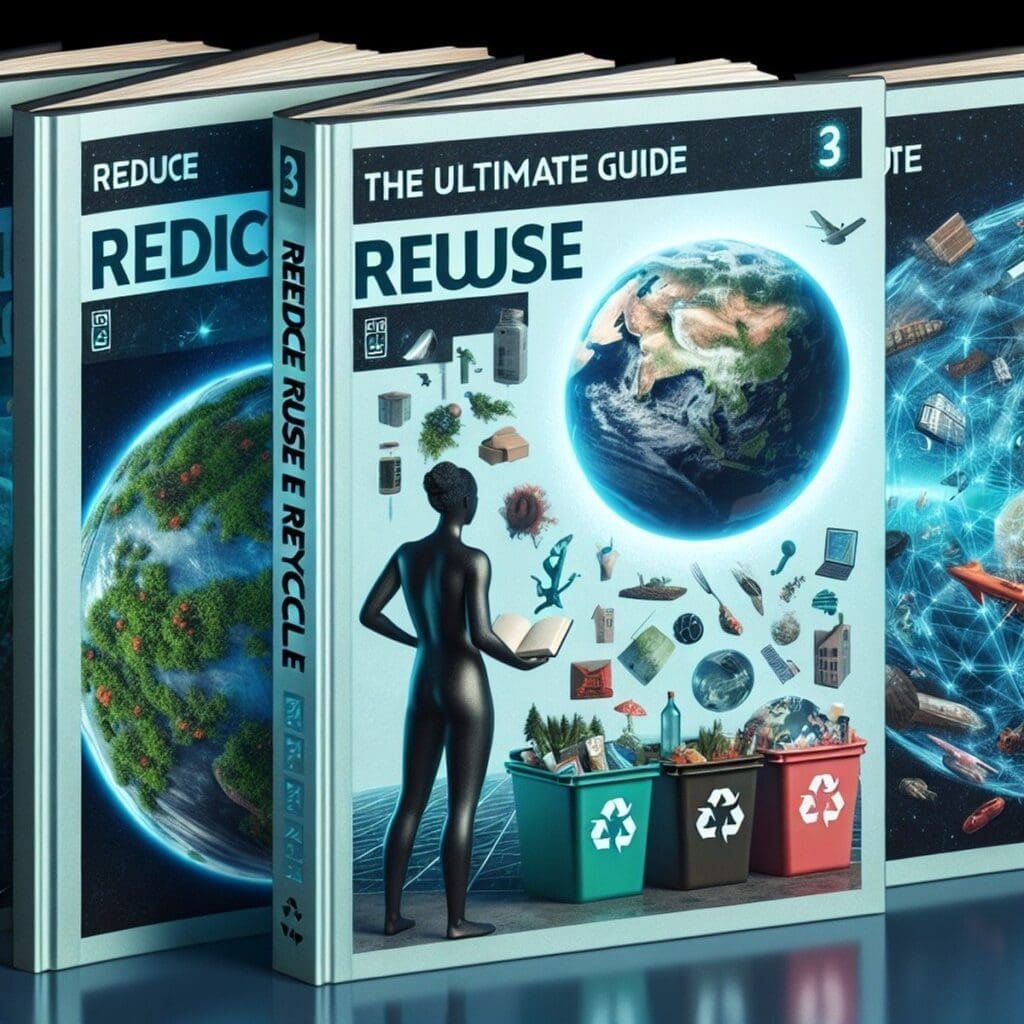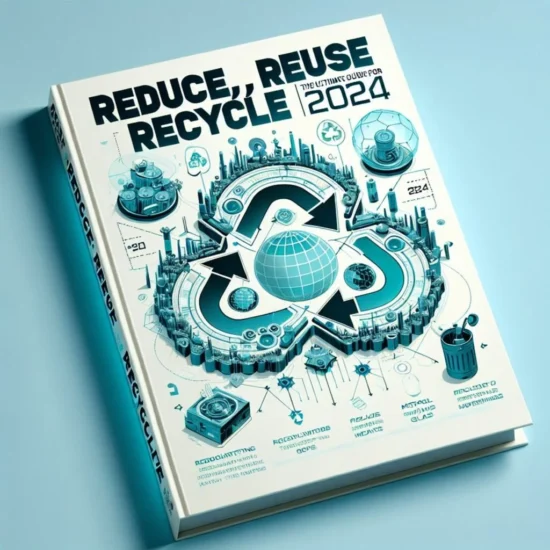
Introduction : Reduce Reuse Recycle
The concept of reduce, reuse, recycle is a fundamental part of sustainable living and waste management. It revolves around minimizing waste production, reusing items as much as possible, and recycling materials for new purposes.
In this guide, we will explore practical ways to incorporate these principles into your daily life for a greener future. Through understanding and implementing the three R’s, you can make a significant impact on the environment and contribute to the conservation of resources.
1. Understanding the Three R’s

The concept of “reduce, reuse, recycle” is fundamental to sustainable living and waste management.
- Reduce: Minimize waste by making conscious consumption choices and opting for products with minimal packaging.
- Reuse: Extend the lifespan of items by finding alternative uses for them, contributing to the circular economy and reducing the volume of discarded items.
- Recycle: Give new life to materials by properly sorting and processing waste for reintegration into the production cycle.
Understanding the impact of landfill sites on the environment is crucial. The Three R’s play a vital role in minimizing the need for landfills by reducing the volume of waste generated and repurposing materials whenever possible.
Recycling materials is also significant as it conserves resources and reduces pollution by minimizing the extraction of raw materials and the energy required for manufacturing new products.
By embracing the principles of reduce, reuse, recycle, individuals can actively contribute to waste reduction and environmental preservation, ultimately fostering a more sustainable future.
2. Practical Ways to Reduce, Reuse, and Recycle
Reducing waste and adopting sustainable practices in our daily lives are crucial steps towards a greener future. By incorporating the principles of reduce, reuse, and recycle into our routines, we can significantly minimize our impact on the environment. Here are some practical ways to implement these principles:
2.1 Reduce: Minimizing Waste Generation
- One of the most effective ways to reduce waste is through conscious consumption choices. By being mindful of what we buy and use, we can minimize our overall waste production.
- When shopping, opt for items that have minimal packaging or choose products that come in recyclable or biodegradable materials. This helps reduce the amount of waste that ends up in landfills.
- Instead of using single-use items like plastic bags and bottles, invest in reusable containers and water bottles. This simple switch can significantly reduce the amount of plastic waste generated.
“By consciously reducing our consumption and opting for reusable alternatives, we can make a significant impact on waste reduction.”
2.2 Reuse: Extending the Lifespan of Items
- Instead of throwing away items that still have life in them, consider repurposing them for different purposes. For example, glass jars can be used as storage containers or vases, and old t-shirts can be transformed into cleaning rags.
- Instead of discarding unwanted items, donate them to charitable organizations or thrift stores. This extends their lifespan and gives others the opportunity to use them.
- Materials like corrugated cardboard can be transformed into storage boxes or even small furniture pieces with a bit of creativity and DIY skills.
“By giving new life to items and embracing the concept of reuse, we can significantly reduce waste generation.”
2.3 Recycle: Giving New Life to Materials
- Educate yourself about the recycling process in your area. Learn what materials can be recycled and how they should be sorted for collection.
- Many companies are now producing innovative products made from recycled materials. For example, plastic lumber is made from recycled plastics and can be used as a sustainable alternative to traditional wood.
- Participate in recycling initiatives such as newspaper recycling or electronic waste collection in your community. These programs ensure that materials are properly recycled and given new life.
“Recycling plays a crucial role in conserving resources and reducing pollution by giving materials a second chance.”
By implementing these practical ways to reduce, reuse, and recycle, we can make significant progress towards a greener future. Remember, every small step counts, and by incorporating these principles into our daily routines, we contribute to a more sustainable world.
2.2. Reuse: Extending the Lifespan of Items

Reducing waste is a crucial aspect of sustainable living, and one effective way to achieve this is through reusing items. By giving items a second or even third life, we can significantly minimize our environmental impact. Here are some practical ideas and tips for extending the lifespan of various items:
Plastic Bags
Instead of throwing away plastic bags after a single use, consider reusing them for future shopping trips. Keep a stash of reusable bags in your car or purse to avoid using plastic bags altogether.
Reusable Containers
Opt for reusable containers instead of disposable ones for packing lunches, storing leftovers, or carrying snacks on the go. This helps reduce the amount of single-use plastic and other packaging waste generated.
Donating
One person’s trash can be another person’s treasure. Instead of throwing away unwanted but still usable items, donate them to charitable organizations. Clothes, furniture, books, and electronics are just a few examples of items that can find new homes through donations.
Repurposing Materials
Get creative and repurpose common materials like corrugated cardboard and glass jars. Cardboard boxes can be transformed into storage organizers or even kid’s playhouses. Glass jars can be used as vases, candle holders, or for storing small items like spices or craft supplies.
Reusing items not only reduces waste but also contributes to the circular economy by keeping resources in use for longer periods. By giving new life to items through reuse, we can conserve valuable resources and reduce the demand for new products.
2.3. Recycle: Giving New Life to Materials
In our previous section, we discussed ways to reduce waste by making conscious choices about what we consume and how it’s packaged. However, waste is inevitable, and that’s where recycling comes in.
The Importance of Proper Sorting and Recycling
- Recycling is the process of converting waste materials into reusable materials.
- By recycling, we can reduce the amount of waste sent to landfills and conserve natural resources.
- It also helps in reducing pollution caused by the extraction and processing of raw materials.
What Happens During the Recycling Process?
- Collection: Waste materials such as plastic bottles, aluminum cans, paper, and cardboard are collected from households or designated recycling bins.
- Sorting: The collected recyclables are sorted based on their material type (e.g., glass, plastic, metal) using various techniques like magnets, optical sensors, and manual sorting.
- Processing: Once sorted, the materials are processed to remove any impurities or contaminants. For example:
- Plastic bottles are cleaned, shredded into small flakes, melted, and then formed into new plastic products.
- Aluminum cans are crushed, baled, melted, and made into new aluminum cans or other aluminum products.
- Paper and cardboard are pulped (mixed with water), cleaned to remove inks and dyes, then dried and rolled into new paper products.
- Manufacturing: The processed materials are used as raw materials by manufacturers to produce new products. This could include:
- Plastic lumber made from recycled plastic used for outdoor decking or furniture.
- Upcycled fashion created from old clothes or fabrics transformed into trendy new designs.
- Market: The recycled products are then sold to consumers who choose to buy them, completing the recycling loop.
Innovative Products Made from Recycled Resources
Here are some examples of innovative products that are made from recycled resources:
- Plastic lumber: A durable and weather-resistant alternative to traditional wood, made from recycled plastic. It can be used for outdoor decking, furniture, fencing, and more.
- Upcycled fashion: Creative designers are repurposing old clothes or fabrics into new and stylish garments, reducing textile waste and promoting sustainable fashion.
- Newspaper pencils: Instead of discarding old newspapers, they can be rolled tightly around graphite sticks to create eco-friendly pencils.
- Recycled glass countertops: Crushed glass mixed with binders to create beautiful and sustainable countertops for kitchens and bathrooms.
By supporting these products, we not only give new life to materials but also contribute to a circular economy where resources are reused and waste is minimized.
“The greatest threat to our planet is the belief that someone else will save it.” – Robert Swan
3. Taking a Holistic Approach: Rethink and Recover
When it comes to reducing waste and living sustainably, it’s important to take a holistic approach. In addition to the three R’s of reduce, reuse, and recycle, there are other factors to consider. Let’s explore how we can rethink our actions and recover waste in a more sustainable way.
3.1. Rethink: Considering Environmental Impact
To truly make a difference in waste reduction and sustainability, it’s crucial to cultivate a mindset of environmental consciousness in all aspects of our lives. Here are some ways you can incorporate this into your daily routine:
- Conscious Consumption: Be mindful of the environmental impact of the products you use and the choices you make. Ask yourself if you really need something before making a purchase. Consider the lifecycle of the product, from production to disposal.
- Support Local Businesses: Look for local businesses that prioritize sustainable practices. By supporting these businesses, you not only contribute to the local economy but also encourage sustainable choices within your community.
- Reduce Energy Consumption: Opt for energy-efficient appliances, turn off lights when not in use, and unplug electronics when they’re not being used. These small changes can add up to significant energy savings over time.
By rethinking our actions and making conscious choices, we can have a positive impact on the environment and encourage others to do the same.
3.2. Recover: Putting Waste to Good Use
In addition to reducing waste and recycling materials, there are alternative waste management approaches that can help us recover valuable resources and minimize landfill diversion. Here are some examples:
- Composting: Instead of throwing organic matter into the trash where it ends up in landfills, consider starting a composting system at home. Composting allows organic waste such as food scraps and yard trimmings to decompose naturally, creating nutrient-rich soil that can be used for gardening.
- Anaerobic Digestion: This technology harnesses energy from waste by breaking down organic materials in the absence of oxygen. It produces biogas, a renewable energy source that can be used for heating, electricity generation, or even as a vehicle fuel.
By putting waste to good use through composting and anaerobic digestion, we can reduce the amount of waste that goes to landfills while also generating valuable resources.
Taking a holistic approach to waste reduction and sustainability is essential for creating a greener future. By rethinking our actions and supporting sustainable practices, we can minimize our environmental impact. Additionally, by exploring alternative waste management methods such as composting and anaerobic digestion, we can recover valuable resources and contribute to a circular economy.
3.2. Recover: Putting Waste to Good Use reduce
Introducing alternative waste management approaches can further enhance the impact of the Three R’s in reducing waste and minimizing environmental harm. Going beyond the traditional methods of reduce, reuse, and recycle, there are additional strategies for waste reduction that deserve our attention. Let’s explore the concept of recover and how it can help put waste to good use.
Composting Organic Matter
Composting is a natural process that turns organic waste, such as food scraps and yard trimmings, into nutrient-rich compost. This method not only diverts waste from landfills but also produces a valuable resource for improving soil health and promoting plant growth. By composting at home or supporting community composting programs, we can significantly reduce organic waste and contribute to a more sustainable environment.
Harnessing Energy from Waste
Another innovative approach to waste management is energy recovery, which involves harnessing energy from waste through technologies like anaerobic digestion. Anaerobic digestion breaks down organic materials in the absence of oxygen, producing biogas that can be used as a renewable energy source. This process not only reduces methane emissions from decomposing waste but also provides a sustainable energy solution.
By implementing these landfill diversion methods, we can address the environmental impact of waste and make sustainable choices that go beyond the traditional Three R’s. Composting organic matter and harnessing energy from waste are powerful ways to turn what would have been discarded into valuable resources.
However, it is important to remember that while these methods contribute to waste reduction, they should not overshadow the primary focus on reducing consumption and reusing items whenever possible. The goal is to prioritize prevention before disposal.
Emphasizing the need to go beyond the Three R’s and consider additional strategies for waste reduction reinforces the concept of environmental consciousness and encourages individuals to think critically about their impact on the planet. By exploring concepts such as environmental impact, sustainability, and the role of individuals in driving systemic change, we can create a more sustainable future for generations to come.
3.3. The Role of Recycling in a Circular Economy
In addition to the principles of reduce and reuse, recycling plays a crucial role in creating a circular economy where materials are kept in continuous circulation. Here’s why recycling is an essential component of sustainable waste management:
- Closing the loop: Recycling allows us to recover valuable resources from waste materials and reintroduce them into the production cycle. Instead of extracting new raw materials, recycling helps conserve resources by reusing existing ones. For example, recycling paper reduces the need for cutting down trees, while recycling aluminum saves energy compared to producing it from scratch.
- Reducing environmental impact: By diverting waste from landfills, recycling helps reduce the pollution and greenhouse gas emissions associated with waste disposal. When organic waste breaks down in landfills, it produces methane, a potent greenhouse gas that contributes to climate change. By recycling organic waste through composting or anaerobic digestion, we can harness its potential as a resource while mitigating its environmental impact.
- Promoting sustainability: Recycling is an integral part of building a sustainable future. It fosters a mindset of environmental consciousness and encourages individuals to make sustainable choices in their daily lives. By actively participating in recycling programs and supporting companies that prioritize closed-loop systems, we contribute to creating a more sustainable society.
- Plastic recycling: Plastic waste poses significant challenges due to its long decomposition time and environmental hazards. Recycling plastic not only diverts it from landfills but also reduces the demand for new plastic production. Through innovative technologies and processes, recycled plastics can be transformed into various products like clothing, furniture, and packaging materials.
By understanding the role of recycling in a circular economy, we can see how our individual actions contribute to systemic change. Emphasizing the need to go beyond the Three R’s and considering additional strategies for waste reduction allows us to make a more significant impact on protecting our environment and conserving valuable resources.
The journey towards a greener future starts with each of us making sustainable choices and actively participating in recycling programs. Together, we can create a world where waste is minimized, resources are conserved, and our planet thrives.
Conclusion
To address the urgent problem of waste generation and protect our planet for future generations, it is essential to embrace the Three R’s:
- Reduce: Minimize the amount of waste we create by being mindful of our consumption habits and making conscious choices.
- Reuse: Find creative ways to repurpose items instead of throwing them away after a single use.
- Recycle: Properly dispose of recyclable materials so that they can be processed and turned into new products.
By following these principles and making sustainable choices, we can all contribute to a cleaner and healthier environment.
So, let’s take action now! Start incorporating the Three R’s into your daily life, beginning with one small change today. Together, we can make a big difference.
FAQs (Frequently Asked Questions)
What is the concept of reduce, reuse, recycle in sustainable living?
The concept of reduce, reuse, recycle in sustainable living emphasizes minimizing waste generation, extending the lifespan of items, and giving new life to materials through proper recycling processes. These principles aim to promote environmental consciousness and support a circular economy model.
Why is it important to understand the impact of landfill sites on the environment?
Understanding the impact of landfill sites on the environment is crucial because they contribute to pollution, greenhouse gas emissions, and land degradation. By embracing the Three R’s – reduce, reuse, recycle – individuals can minimize the need for landfill sites and help conserve natural resources.
How can individuals incorporate reduce, reuse, and recycle into their daily lives?
Individuals can incorporate reduce, reuse, and recycle into their daily lives by making conscious consumption choices, opting for products with less packaging, choosing reusable alternatives over single-use items like plastic bags and bottles, reusing items instead of discarding them, donating unwanted but still usable items to charitable organizations, and properly sorting and recycling waste materials.
What are some practical tips for minimizing waste generation through conscious consumption?
Practical tips for minimizing waste generation through conscious consumption include choosing products with less packaging, preferring reusable alternatives over single-use items like plastic bags and bottles, and supporting businesses that prioritize sustainable practices.
How can individuals extend the lifespan of items through the concept of reusing?
Individuals can incorporate reduce, reuse, and recycle into their daily lives by making conscious consumption choices, opting for products with less packaging, choosing reusable alternatives over single-use items like plastic bags and bottles, reusing items instead of discarding them, donating unwanted but still usable items to charitable organizations, and properly sorting and recycling waste materials.
What is the significance of recycling in a circular economy model?
Recycling plays a significant role in a circular economy model as it forms the foundation for keeping materials in continuous circulation. Along with reduce and reuse, recycling contributes to creating closed-loop systems where materials are used efficiently and sustainably. Supporting recycling efforts is essential for promoting a circular economy.
sustainable living environmental conservation waste management green living eco-friendly practices zero waste lifestyle upcycling ideas composting methods plastic pollution solutions conscious consumption carbon footprint reduction environmental sustainability ethical consumption green initiatives waste reduction strategies






